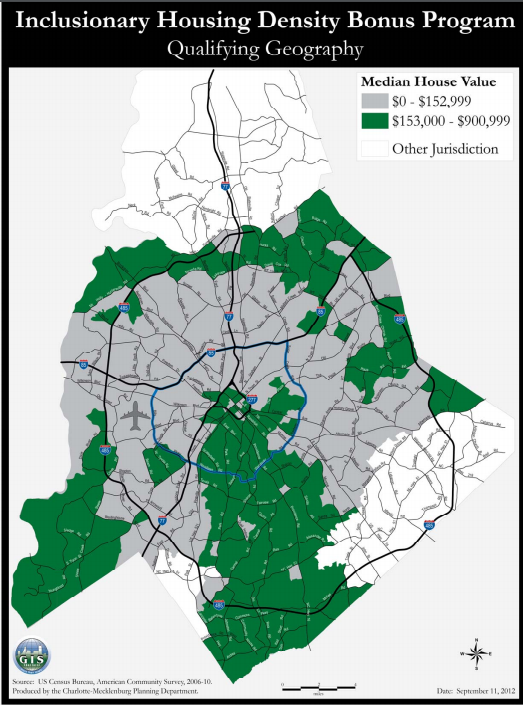This memo highlights lessons learned from U.S. cities that have implemented effective but flexible inclusionary housing policies including three main types of practices: (1) geographically targeted policies by census tract; (2) policies limited to specific zoning districts; and (3) policies which vary by project type. View memo
Most cities do not adjust their inclusionary requirements at a neighborhood level. To some degree, many inclusionary requirements automatically compensate for different market conditions. For instance, it may be more expensive to build in high-cost neighborhoods, but a density bonus is worth more where the home prices or rents are higher.
In some neighborhoods, development may not be feasible even without any inclusionary housing requirements. Often these neighborhoods have suffered from disinvestment for many years, and these may be areas where cities are particularly interested in encouraging new housing development. If this is the case, cities sometimes reduce requirements and increase incentives.
Burlington, Vermont
Burlington requires 15 percent affordable units citywide, but it requires 25 percent of units to be affordable in higher-cost waterfront areas.
Chapel Hill, North Carolina
Chapel Hill has lowered their requirements in the highest density areas because higher-density construction can be significantly more expensive.
Fairfax County, Virginia
Fairfax County varies requirements by construction type rather than by neighborhood. The requirements range from 5 percent in developments with structured parking to 12.5 percent in single-family and low-rise multifamily developments with a sliding-scale density bonus.
Austin, Texas
Austin has a voluntary program that offers incentives in exchange for affordable units only in certain zoning districts.
Charlotte, North Carolina
 Charlotte’s voluntary incentive-based policy applies only in certain zones. These correspond to Census block groups with median home values at or above the area median according to five-year estimates from the American Community Survey.
Charlotte’s voluntary incentive-based policy applies only in certain zones. These correspond to Census block groups with median home values at or above the area median according to five-year estimates from the American Community Survey.
Geographically targeted programs such as these may be more complex to design and administer, and they still may fail to capture all the important fine-grained differences among projects.
In any case, the findings of an economic feasibility study would drive a decision to vary affordable housing requirements by neighborhood or construction type. For example, if the study were to show that generally supportable requirements would likely have an adverse impact on the feasibility of otherwise desirable development types in certain areas, a program might be refined to adjust the requirement in the areas likely to be impacted.
Common Questions
It is important for cities to be aware of market conditions when they set their inclusionary housing requirements, both for the entire city and for various neighborhoods.
Most cities do not adjust their inclusionary requirements at a neighborhood level. For cities without wide variations in neighborhood market conditions, this may be appropriate because incentives and inclusionary requirements automatically compensate for differences in market conditions. For example, it may be more expensive to build in high-cost neighborhood, but a density bonus is worth more in neighborhoods where home prices or rents are higher.
Some cities, however, have responded to concern about the impact of inclusionary requirements in certain sensitive neighborhoods by varying their requirements or incentives by neighborhood. This is called geographic tiering.
Rather than vary the requirements by neighborhood, some cities vary their requirements based on construction type. These are generally places where local market conditions make higher-density construction economically marginal enough that affordable housing requirements can become a barrier to development.
The decision to vary affordable housing requirements by neighborhood or construction type should typically be made based on the findings of an economic feasibility study. In general, a city may want to pursue these varying requirements if the feasibility study showed that citywide supportable requirements would have an adverse impact on the feasibility of otherwise desirable development in certain areas.
Inclusionary housing programs create affordable homeownership opportunities in three distinct ways:
- On-site homeownership units. When developers produce for-sale projects, most inclusionary housing programs require developers of ownership projects to provide affordable ownership units.
- Homebuyer assistance loan programs. Many cities directly operate purchase-assistance loan programs that make gap funding available to income-qualified homebuyers. These programs are sometimes called down-payment assistance, even though the levels of public subsidy often exceed what would be typical for a down payment.
- Nonprofit homeownership projects. Many inclusionary housing programs invest a portion of revenue from in-lieu fees or housing development impact fees in homeownership development projects sponsored by local nonprofit housing developers. These projects might be new construction of affordable homes or renovations of existing housing homes.


